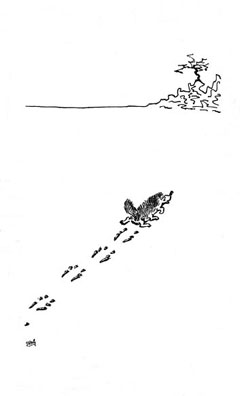
 |
de Steensplinter — Geology and a cosmology of the obvious | 4.3 groundwork |
 • a snubnosed bushytail running over a newly laid soft sediment, leaving footprints behind it (drawing by Nicolien Bottema - Mac Gillavry). previous (website version 2.30 - august 2007) |
groundwork [continued] 1. preview 2. geology, a key to the past 3. some evidence 4. formation of a bivalve shell 5. causality 6. inorganic processes some evidence footprints The running animal (left) leaves a trail of footprints on the surface of a newly-laid layer of soft sediment. All the footprints are behind it. There are no prints in front of it and you can draw a time-line along its path: • the part with the prints is the past. • where the animal is now is the present. • the future has no prints. Nobody has ever seen footprints of an animal that has not yet been there. The past is marked, the future is not. The mark is a mark of form. what about the future? Should the animal continue to run, then there will be new footprints where now there are none. But again all footprints will be behind it, none in front. And again they will belong to what then will be the past. Or the animal is shot or chooses to stop running. Then that part of the extended new past will have no footprints. The choice to stop running or to continue need not be an entirely free choice, for instance if it stops because of a sudden noise, or the sight of danger. but all that is irrelevant The only thing relevant to our discussion is, that the past is marked by the footprints. The animal is no longer there. But it will also have left a trail of smell, which we cannot perceive, but which a dog can sniff. This trail of smell will be short-lived. The footprints can be wiped out by later events, such as a strong wind or a flood of water. Then they are also short-lived. But they may also be overlaid by a new layer of sediment. Then they may be preserved when these sediments are subsequently lithified. Millions of years later in what then is an entirely new present, a geologist may be passing. and he will observe and analyze these footprints and try to figure out what kind of animal made them: Where did it come from? Where did it go? The footprints on the top of the first layer are a mark of form. Those on the underside of the overlying sediment layer are casts and thus will be marks of substance and form. in short: The process of the running animal, a four-dimensional process of change of shape in a lapse of time, left the following three-dimensional records: (a) a record of smell, which, because of its volatility, has not been preserved; this is a purely material record, consisting of substances emitted and left behind by the passing animal; (b) a record of form, the foot-prints on the top of the underlying layer of sediment; (c) a record of substance and form, the casts of the footprints on the underside of the overlying layer of sediment. Involved in this example are (besides the process of the running animal): • in (a) the subsequent process of evaporation; • in (b) and (c) the deposition of the covering layer, the subsequent process of lithification, a later process of folding of these sediments and their uncovering afterwards by a process of erosion. And the process of the arrival of a geologist. continued |
| © 2007 - uitgeverij de Steensplinter - All rights reserved |